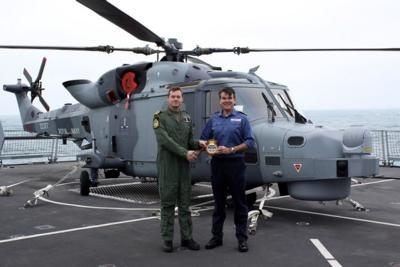Mon, Mar 24, 2014
Aircraft Will Replacing The Lynx Mark 8 For The U.K. Royal Navy
A Wildcat, the navy's next-generation helicopter, has landed for the first time on the flight deck of a Type 45 destroyer at sea. The Royal Navy’s Wildcat, the maritime attack variant of the Lynx helicopter, is currently undergoing extensive trials with 700W Naval Air Squadron. As part of those trials, the aircraft has been working at the MOD’s aerial range in Cardigan Bay.

From next year, Wildcat will begin to replace the Lynx Mark 8 as the helicopter which supports Royal Navy destroyer and frigate operations around the world. The inaugural arrival of Wildcat on HMS Dragon went seamlessly and the whole ship’s company got the chance to take a look at and admire the latest addition to the Fleet Air Arm.
“Today is a small, but exciting, step in the progression of this new capability and I am delighted that HMS Dragon was able to help," said Captain Iain Lower, the Type 45’s commanding officer. I look forward to seeing what the aircraft can do when we put it through its paces later this month.”
After the brief visit, Wildcat will be a more permanent presence on board Dragon later this month as, for the first time, the helicopter is embarking on the ship for the latest Exercise Joint Warrior; a biannual exercise in which British and foreign armed forces hone their skills off the coast of Scotland for up to 3 weeks.
Lieutenant Commander Simon Collins, commanding officer of 700W Naval Air Squadron, flew over to HMS Dragon with his squadron colleagues. “This year will be one of many firsts for the Wildcat crews as we work with our industry partners to get the aircraft to sea as soon as we can," Collins said. “Deck landings on board a Type 45 at sea are a real milestone and it was a pleasure to join the HMS Dragon team to show them what Wildcat can do.”
The Wildcat roll-out program continues apace, and plans are in motion for the current flight to be the first to complete operational sea training with a Type 23 frigate in the autumn.
(Image provided by the U.K. Royal Navy)
More News
Known Traffic With respect to ATC clearances, means aircraft whose altitude, position, and intentions are known to ATC.>[...]
Aero Linx: Aviation Suppliers Association (ASA) Established February 25, 1993, the Aviation Suppliers Association (ASA), based in Washington, D.C., is a not-for-profit association,>[...]
Abeam An aircraft is “abeam” a fix, point, or object when that fix, point, or object is approximately 90 degrees to the right or left of the aircraft track. Abeam indic>[...]
Aero Linx: The Air Charter Safety Alliance The group, called the Air Charter Safety Alliance, will raise awareness of illegal charter flights among potential customers, charter bro>[...]
“For months, ALPA has been sounding the alarm on the ongoing efforts by some aircraft manufacturers to remove pilots from the flight deck and replace them with automation. To>[...]
 ANN's Daily Aero-Term (06.10.24): Known Traffic
ANN's Daily Aero-Term (06.10.24): Known Traffic ANN's Daily Aero-Linx (06.10.24)
ANN's Daily Aero-Linx (06.10.24) ANN's Daily Aero-Term (06.11.24): Abeam
ANN's Daily Aero-Term (06.11.24): Abeam ANN's Daily Aero-Linx (06.11.24)
ANN's Daily Aero-Linx (06.11.24) Aero-News: Quote of the Day (06.11.24)
Aero-News: Quote of the Day (06.11.24)



